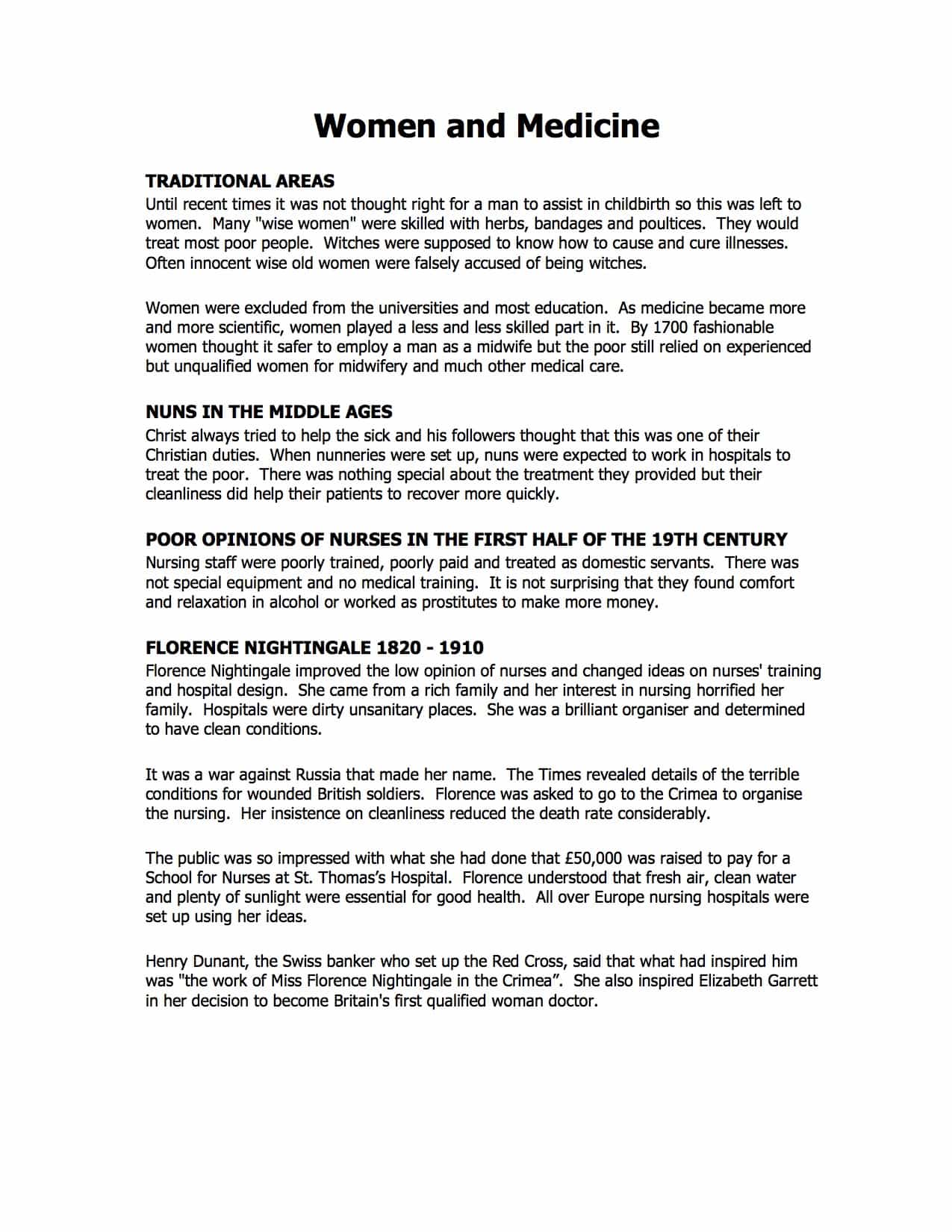Download Women and Medicine
Click the button below to download this worksheet for use in the classroom or at home.
Download →
TRADITIONAL AREAS
Until recent times it was not thought right for a man to assist in childbirth so this was left to women. Many “wise women” were skilled with herbs, bandages and poultices. They would treat most poor people. Witches were supposed to know how to cause and cure illnesses. Often innocent wise old women were falsely accused of being witches.
Women were excluded from the universities and most education. As medicine became more and more scientific, women played a less and less skilled part in it. By 1700 fashionable women thought it safer to employ a man as a midwife but the poor still relied on experienced but unqualified women for midwifery and much other medical care.
NUNS IN THE MIDDLE AGES
Christ always tried to help the sick and his followers thought that this was one of their Christian duties. When nunneries were set up, nuns were expected to work in hospitals to treat the poor. There was nothing special about the treatment they provided but their cleanliness did help their patients to recover more quickly.
POOR OPINIONS OF NURSES IN THE FIRST HALF OF THE 19TH CENTURY
Nursing staff were poorly trained, poorly paid and treated as domestic servants. There was not special equipment and no medical training. It is not surprising that they found comfort and relaxation in alcohol or worked as prostitutes to make more money.
FLORENCE NIGHTINGALE 1820 – 1910
Florence Nightingale improved the low opinion of nurses and changed ideas on nurses’ training and hospital design. She came from a rich family and her interest in nursing horrified her family. Hospitals were dirty unsanitary places. She was a brilliant organiser and determined to have clean conditions.
It was a war against Russia that made her name. The Times revealed details of the terrible conditions for wounded British soldiers. Florence was asked to go to the Crimea to organise the nursing. Her insistence on cleanliness reduced the death rate considerably.
The public was so impressed with what she had done that £50,000 was raised to pay for a School for Nurses at St. Thomas’s Hospital. Florence understood that fresh air, clean water and plenty of sunlight were essential for good health. All over Europe nursing hospitals were set up using her ideas.
Henry Dunant, the Swiss banker who set up the Red Cross, said that what had inspired him was “the work of Miss Florence Nightingale in the Crimea”. She also inspired Elizabeth Garrett in her decision to become Britain’s first qualified woman doctor.
WOMEN STRUGGLE TO BECOME DOCTORS IN THE 19TH CENTURY
ELIZABETH BLACKWELL
The first woman in modern times to qualify as a doctor was Elizabeth Blackwell, an American teacher. She taught herself basic science (a subject not normally taught to girls) and saved enough money to pay for her studies. Most medical schools refused to accept her but students at a small medical college in New York voted to accept her. She qualified in 1849 and at first found it difficult to find work. In 1853 she set up a successful clinic in New York for poor women and children.
ELIZABETH GARRETT
Elizabeth Blackwell came to Europe and her example encouraged Elizabeth Garrett to become a doctor. She had a good education and plenty of money. She had problems. She did qualify but had to join a professional body. she had to take the Society of Apothecaries to court before they would accept her. No British university would let her study to become a Doctor of Medicine so she learned French and qualified in Paris. In the 1870s other women had to go abroad to gain the necessary degrees.
In 1876 Parliament passed an Act allowing women to gain medical qualifications in British universities. Today only about 20% of the doctors in England and Wales are women.
PDF Worksheet:
-
- Aimed at Students studying at UK GCSE or equivalent
- Free to download
- Use as you wish in the classroom or home environment
- Structured study guide and challenging questions.
